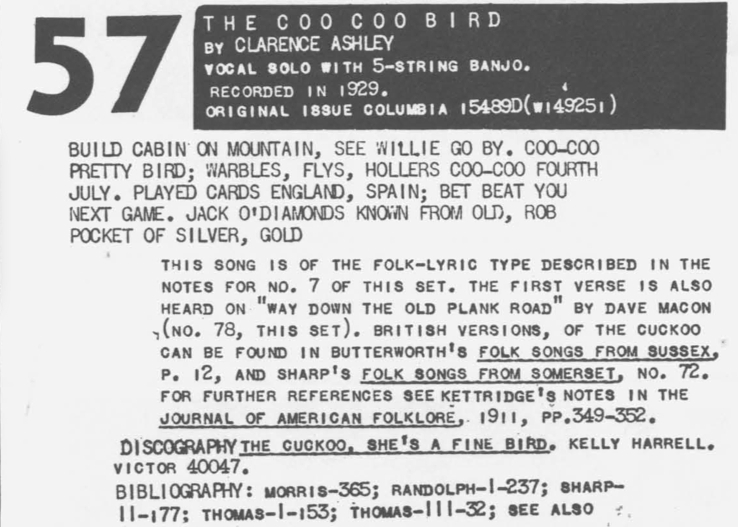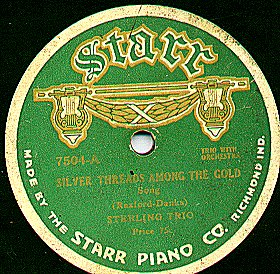|
Leonard Rutherford
Leonard Rutherford (March 22, 1898 – June 30, 1951) was an American old-time fiddle player from Kentucky, United States. He was a full-time live-entertainer and recording artist, but lacking any inclination for showmanship he performed in partnerships. For thirty-five years he toured with banjoist Dick Burnett, making a number of highly regarded recordings in 1926–1928. He formed a shorter recording partnership (1929 -1934) with guitarist and singer John D Foster but continued to play with Burnett. Rutherford was born in Somerset, Kentucky and lived most of his life in Monticello, Kentucky. Rutherford has been described as "one of the prettiest of old time fiddlers, and he could sing too" and "a versatile, long bow fiddler with an exceptionally sweet tone and a repertoire that included modern songs and tunes, as well as old-time tunes". Dick Burnett's verdict was more mixed: "He could play that fiddle, he was the best in the world, but he wouldn't do nothin' else. You've go ... [...More Info...] [...Related Items...] OR: [Wikipedia] [Google] [Baidu] |
Old-time Music
Old-time music is a genre of North American folk music. It developed along with various North American folk dances, such as square dancing, clogging, and buck dancing. It is played on acoustic instruments, generally centering on a combination of fiddle and plucked string instruments, most often the banjo, guitar, and mandolin. The genre is considered a precursor to modern country music. History Reflecting the cultures that settled North America, the roots of old-time music are in the traditional musics of the British Isles and Europe. African influences are notably found in instruments such as the banjo. In some regions French and German sources are also prominent. While many dance tunes and ballads can be traced to European sources, many others are of North American origin. The term "old-time" Old-time music represents perhaps the oldest form of North American traditional music other than Native American music, and thus the term "old-time" is an appropriate one. Fi ... [...More Info...] [...Related Items...] OR: [Wikipedia] [Google] [Baidu] |
Anthology Of American Folk Music
''Anthology of American Folk Music'' is a three-album compilation, released in 1952 by Folkways Records, of eighty-four recordings of American folk, blues and country music made and issued from 1926 to 1933 by a variety of performers. The album was compiled from experimental film maker Harry Smith's own personal collection of 78 rpm records. Upon its release the Anthology did not gain recognition as it had sold relatively poorly and had no notable early coverage besides a minor 1958 mention in ''Sing Out!.'' The album is now, however, generally regarded as a landmark release in the history of the album as well as an influential release during the 1950s and 1960s for the American folk music revival. In 2003, ''Rolling Stone'' ranked the album at number 276 on their list of The 500 Greatest Albums of All Time, and, in 2005, the album was inducted into the National Recording Registry by the Library of Congress. Background Harry Smith was a West Coast filmmaker, magickian, bohemian, ... [...More Info...] [...Related Items...] OR: [Wikipedia] [Google] [Baidu] |
Year Of Birth Uncertain
A year or annus is the orbital period of a planetary body, for example, the Earth, moving in its orbit around the Sun. Due to the Earth's axial tilt, the course of a year sees the passing of the seasons, marked by change in weather, the hours of daylight, and, consequently, vegetation and soil fertility. In temperate and subpolar regions around the planet, four seasons are generally recognized: spring, summer, autumn and winter. In tropical and subtropical regions, several geographical sectors do not present defined seasons; but in the seasonal tropics, the annual wet and dry seasons are recognized and tracked. A calendar year is an approximation of the number of days of the Earth's orbital period, as counted in a given calendar. The Gregorian calendar, or modern calendar, presents its calendar year to be either a common year of 365 days or a leap year of 366 days, as do the Julian calendars. For the Gregorian calendar, the average length of the calendar year (the ... [...More Info...] [...Related Items...] OR: [Wikipedia] [Google] [Baidu] |
People From Wayne County, Kentucky
A person ( : people) is a being that has certain capacities or attributes such as reason, morality, consciousness or self-consciousness, and being a part of a culturally established form of social relations such as kinship, ownership of property, or legal responsibility. The defining features of personhood and, consequently, what makes a person count as a person, differ widely among cultures and contexts. In addition to the question of personhood, of what makes a being count as a person to begin with, there are further questions about personal identity and self: both about what makes any particular person that particular person instead of another, and about what makes a person at one time the same person as they were or will be at another time despite any intervening changes. The plural form "people" is often used to refer to an entire nation or ethnic group (as in "a people"), and this was the original meaning of the word; it subsequently acquired its use as a plural form of p ... [...More Info...] [...Related Items...] OR: [Wikipedia] [Google] [Baidu] |
Country Musicians From Kentucky
A country is a distinct part of the world, such as a state, nation, or other political entity. It may be a sovereign state or make up one part of a larger state. For example, the country of Japan is an independent, sovereign state, while the country of Wales is a component of a multi-part sovereign state, the United Kingdom. A country may be a historically sovereign area (such as Korea), a currently sovereign territory with a unified government (such as Senegal), or a non-sovereign geographic region associated with certain distinct political, ethnic, or cultural characteristics (such as the Basque Country). The definition and usage of the word "country" is flexible and has changed over time. ''The Economist'' wrote in 2010 that "any attempt to find a clear definition of a country soon runs into a thicket of exceptions and anomalies." Most sovereign states, but not all countries, are members of the United Nations. The largest country by area is Russia, while the smallest i ... [...More Info...] [...Related Items...] OR: [Wikipedia] [Google] [Baidu] |
Appalachian Old-time Fiddlers
Appalachian may refer to: * Appalachian Mountains, a major mountain range in eastern United States and Canada * Appalachian Trail, a hiking trail in the eastern United States * The people of Appalachia and their culture ** Appalachian Americans, ethnic group native to Appalachia ** Appalachian English, the variety of English native to Central and Southern Appalachia ** Appalachian music * Appalachian State University Appalachian State University (; Appalachian, App State, App, or ASU) is a public university in Boone, North Carolina. It was founded as a teachers college in 1899 by brothers B. B. and D. D. Dougherty and the latter's wife, Lillie Shull Dough ..., in Boone, North Carolina See also * Appalachia (other) * * Appellation (other) {{Disambiguation ... [...More Info...] [...Related Items...] OR: [Wikipedia] [Google] [Baidu] |
Brunswick Records
Brunswick Records is an American record label founded in 1916. History From 1916 Records under the Brunswick label were first produced by the Brunswick-Balke-Collender Company, a company based in Dubuque, Iowa which had been manufacturing products ranging from pianos to sporting equipment since 1845. The company first began producing phonographs in 1916, then began marketing their own line of records as an afterthought. These first Brunswick records used the vertical cut system like Edison Disc Records, and were not sold in large numbers. They were recorded in the United States but sold only in Canada. 1920s In January 1920, a new line of Brunswick Records was introduced in the U.S. and Canada that employed the lateral cut system which was becoming the default cut for 78 discs. Brunswick started its standard popular series at 2000 and ended up in 1940 at 8517. However, when the series reached 4999, they skipped over the previous allocated 5000s and continued at 6000. Whe ... [...More Info...] [...Related Items...] OR: [Wikipedia] [Google] [Baidu] |
Gennett
Gennett (pronounced "jennett") was an American record company and label in Richmond, Indiana, United States, which flourished in the 1920s. Gennett produced some of the earliest recordings by Louis Armstrong, King Oliver, Bix Beiderbecke, and Hoagy Carmichael. Its roster also included Jelly Roll Morton, Blind Lemon Jefferson, Charley Patton, and Gene Autry. History Gennett Records was founded in Richmond, Indiana, by the Starr Piano Company. It released its first records in October 1917. The company was named for its managers: Harry, Fred and Clarence Gennett. The company had produced early recordings under the Starr Records label. The early issues were vertically cut in the gramophone record grooves, using the hill-and-dale method of a U-shaped groove and sapphire ball stylus, but they switched to the lateral cut method in April 1919. Gennett set up recording studios in New York City and later, in 1921, set up a second studio on the grounds of the piano factory in Richmond und ... [...More Info...] [...Related Items...] OR: [Wikipedia] [Google] [Baidu] |
American Folk Music Revival
The American folk music revival began during the 1940s and peaked in popularity in the mid-1960s. Its roots went earlier, and performers like Josh White, Burl Ives, Woody Guthrie, Lead Belly, Big Bill Broonzy, Billie Holiday, Richard Dyer-Bennet, Oscar Brand, Jean Ritchie, John Jacob Niles, Susan Reed, Paul Robeson, Bessie Smith, Ma Rainey and Cisco Houston had enjoyed a limited general popularity in the 1930s and 1940s. The revival brought forward styles of American folk music that had in earlier times contributed to the development of country and western, blues, jazz, and rock and roll music. Overview Early years The folk revival in New York City was rooted in the resurgent interest in square dancing and folk dancing there in the 1940s as espoused by instructors such as Margot Mayo, which gave musicians such as Pete Seeger popular exposure. The folk revival more generally as a popular and commercial phenomenon begins with the career of The Weavers, formed in November 19 ... [...More Info...] [...Related Items...] OR: [Wikipedia] [Google] [Baidu] |
Frank Buckley Walker
Francis Buckley Walker (October 24, 1889 – October 15, 1963) was an American talent agent and author from the New York City area. Some of his talent discoveries included country music singer Hank Williams, blues singer Bessie Smith and banjoist Samantha Bumgarner. He is known for running the Johnson City sessions from 1928 to 1929, which launched the careers of various artists including Charlie Bowman and Clarence Ashley. In 1923, Walker became the head of A&R for Columbia Records and RCA Victor. His career as a talent agent lasted for over 40 years until his death in 1963. Early life Frank Walker was born on a farm in rural Fly Summit, a hamlet in Cambridge, New York, on October 24, 1889. He was the youngest of seven children born to Mary Ann Buckley (August 13, 1851 – April 25, 1922) and Solomon Walker (June 14, 1852 – November 6, 1895). Frank and his brothers, Lester, George, Mack and Ed worked on the farm as children and helped with income for the family. T ... [...More Info...] [...Related Items...] OR: [Wikipedia] [Google] [Baidu] |
Fiddle
A fiddle is a bowed string musical instrument, most often a violin. It is a colloquial term for the violin, used by players in all genres, including classical music. Although in many cases violins and fiddles are essentially synonymous, the style of the music played may determine specific construction differences between fiddles and classical violins. For example, fiddles may optionally be set up with a bridge with a flatter arch to reduce the range of bow-arm motion needed for techniques such as the double shuffle, a form of bariolage involving rapid alternation between pairs of adjacent strings. To produce a "brighter" tone than the deep tones of gut or synthetic core strings, fiddlers often use steel strings. The fiddle is part of many traditional ( folk) styles, which are typically aural traditions—taught " by ear" rather than via written music. Fiddling is the act of playing the fiddle, and fiddlers are musicians that play it. Among musical styles, fiddling tends to ... [...More Info...] [...Related Items...] OR: [Wikipedia] [Google] [Baidu] |


_1938.jpg)


